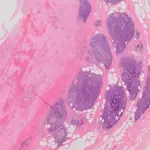Neuroendocrine tumor of the gallbladder is a unique heterogeneous neoplasm originating from neuroendocrine cells and able to secrete peptides as its neurotransmitter.
What is the Pathology of Neuroendocrine Tumor of the Gallbladder?
The pathology of neuroendocrine tumor of the gallbladder is:
-Etiology: The cause of neuroendocrine tumor of the gallbladder is due to overproduction of neoplastic neuroendocrine cells.
-Genes involved: Epidermal growth factor receptor (EGFR), vascular endothelial growth factor (VEGF).
-Pathogenesis: The sequence of events that lead to a neuroendocrine tumor of the gallbladder is the inflammation that produces neuroendocrine cells at the lesion site eventually leading to its development.
-Morphology: The morphology associated with a neuroendocrine tumor of the gallbladder may show vague abdominal symptoms.
-Histology: The histology associated with a neuroendocrine tumor of the gallbladder shows shows cells that are small, cone-shaped, and polygonal, with no clear cell boundaries. Its cells have small nucleoli, granular chromatin, relatively consistent tumor cell morphology, and are rich in interstitial blood vessels.
How does Neuroendocrine Tumor of the Gallbladder Present?
Patients with neuroendocrine tumor of the gallbladder typically are female. The symptoms, features, and clinical findings associated with a neuroendocrine tumor of the gallbladder include nausea, abdominal distension, and abdominal pain.
How is Neuroendocrine Tumor of the Gallbladder Diagnosed?
Neuroendocrine tumor of the gallbladder is diagnosed with tumor markers and imaging examinations, such as ultrasound, computed tomography (CT), magnetic resonance imaging (MRI), and biopsy.
How is Neuroendocrine Tumor of the Gallbladder Treated?
Neuroendocrine tumor of the gallbladder is treated with surgery.
What is the Prognosis of Neuroendocrine Tumor of the Gallbladder?
The prognosis of a neuroendocrine tumor of the gallbladder is fair.



